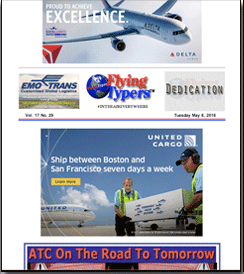|
 The
air freight sector’s remarkable upturn in fortunes could soon be
coming to an end, according to one leading market analyst. But while the
current supply-demand balance could be threatened by new capacity, digitalization
of the sector will create new opportunities. The
air freight sector’s remarkable upturn in fortunes could soon be
coming to an end, according to one leading market analyst. But while the
current supply-demand balance could be threatened by new capacity, digitalization
of the sector will create new opportunities.
Patrik Berglund, CEO of Xeneta, a benchmarking
and market intelligence platform, believes that although forecasters such
as McKinsey have predicted air cargo volumes will rise by 3 percent on
average through to 2025, problems are now brewing for air freight stakeholders.
Downward
Pricing
He said that with carriers lining up to buy freighter
aircraft, and bellyhold capacity expanding in line with passenger operations,
carriers would soon face downward pricing pressure that could negate volume
gains. “We think supply could quite rapidly catch up with demand,
so there will be a pricing correction, probably during 2018,” he
added.
“Our customers have reported that they
mainly choose air over ocean, for example, because of the obvious advantage
of speed, especially when supply chain kinks emerge. So, my take is that
how the ocean market performs in terms of reliability with the various
alliances now operating will have a strong bearing on air cargo demand.”
New Rate
Service
Xeneta launched its new benchmarking rate service
for air cargo at the end of last year, expanding from its ocean freight
benchmarking business. ‘Beta’ testing is ongoing with customers
and the full product is due to go live in June.
Berglund believes more and more transactions
will inevitably be digitalized and this will transform the industry.
“The air cargo industry is facing serious
disruption through digitalization which will change the way the industry
operates as a whole,” he added.
“New technologies can provide invaluable
resources to an industry, but their disruptive nature can make it hard
for some companies to adapt, whether it be due to cost constraints or
the challenge of implementation.”
New Entrants
Challenge
Carriers and forwarders, he said, had been slow
to understand the threat posed by new entrants.
“As other sectors of the freight industry
have turned towards digitalization as a means of serving their customers,
air freight has been the last holdout against disruptive technologies
with many still relying, like in the ocean shipping sector, on a never-ending
stream of phone calls and emails to book and manage shipments,”
he added.
But pressure to digitalize will continue to grow,
not least because new entrants are targeting market niches in the air
freight value chain, or offering products to incumbents with similar—or
better—service standards but lower prices.
“Given that most systems are turning towards
automation for increased efficiency, it follows that the air freight industry
must also go digital,” said Berglund.
“As forwarders learn to utilize new technologies,
they’ll be able to make their teams more efficient while building
longer and stronger business relationships, which in turn increases their
chances of growing their bottom line.”
Understanding
The Obstacles
Quoting a recent McKinsey report, he said that
when customers do use online channels to find forwarders and to book and
manage their shipments, they faced multiple obstacles, “for example,
only 60 percent of carriers and forwarders offer online registration.”
And, he added, the number now providing online
quotes was lower than 60 percent. “These breakpoints explain why
so many start-ups—and some investors—see huge potential in
disrupting the freight-forwarding business.”
Marrying
Technologies
With shippers demanding better services, more
competitive prices, and easy and convenient access to shipment information,
companies that succeed will be those best able to marry the best of traditional
forwarding services to new technology. “As new technologies become
widely accessible to all companies and forwarders throughout the industry,
it’s the extra mile given to customer service that becomes a differentiator
for companies who are trying to compete in a market with extremely tight
margins and even tighter competition,” he said.
“Digital booking is a prime example of
where air freight is woefully behind the rest of the shipping and logistics
industry. For customers that don’t use electronic data interchange,
booking freight online is not simple.
“Companies that have made the process easier
for their customers have gained market share over forwarders that aren’t
utilizing the new technology. This helps to highlight the growing interest
in digitalization and shows a potential market for new businesses, business
models, and technologies.”
Outdated
Practices
Berglund also argued that air freight procurement
now faced the same level of volatility and complexity as the container
shipping industry.
“Archaic practices and dated processes
coupled with exhaustive tendering periods leads to inefficiency,”
he added. “This has given birth to the development of air and ocean
cargo benchmark and market intelligence platforms like ours and other
market indices.”
It Ain’t
Easy
But although new technology can improve customer
interactions and back-end functions, 3PLs looking to upgrade systems do
not face easy decisions, not least when deciding whether to build or buy
a marketplace or partner with an emerging one.
Berglund also said forwarders should guard against
losing the qualities that differentiate them from their competitors as
they modernize. “By complementing that strength with digital freight
technologies, logistics companies will have a better chance of standing
out,” he added.
He also argued that 100 percent digital air freight
forwarding companies would find it tough to succeed.
“In many cases I’d argue that freight
forwarding for any mode of transport can’t go fully digital without
any physical footprint,” he explained.
“It’s not possible to offer the same
level of service otherwise.”
Time Is On
My Side
“We must not forget that legacy players
have been in the game for a significant amount of time.
“They are in a strong position to fully
pivot and adopt the latest innovations.
“And they have the capital to spend on
resources for development, implementation, and training.
“Nonetheless, we are in good company with
tech start-ups who are changing the game and who bring a fresh look into
the industry.
“More competition and innovation needs
to continue to happen in the market.”
SkyKing
|




 Vol.
17 No. 29
Vol.
17 No. 29 Vol.
17 No. 30
Vol.
17 No. 30